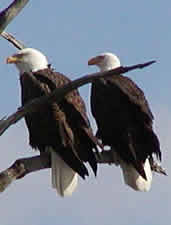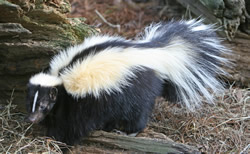The arrival of the February marks winter's mid-point but by month's end spring is just around the corner. So while the winter woods may appear to be still, a closer look reveals quite a bit of activity.
Here are some things to look and listen for during the month:
 Bald eagles begin laying eggs.
Bald eagles begin laying eggs.
- Gray squirrels, active all winter, start racing and chasing about as they court and establish territories.
- Overwintering cardinals, carolina wrens and chickadees look for nesting sites on warm days. Mockingbirds maintain their winter feeding territories. See if you can spot them in Huber Woods Park, Middletown.
- Red foxes begin courting; listen for their yaps and barks late at night. They have been spotted in Thompson Park, Lincroft.
- Red-winged blackbirds return and sing in the marshes.
- Listen for the howling of eastern coyotes whose breeding season has begun.
During this month:
- Sugar maple trees start running sap.
- Skunk cabbage may appear in the moist soil of wetlands. Look for it while walking the 5-mile perimeter trail at the Mansquan Reservoir, Howell.
- Red maple, which can be found in Perrineville Lake Park, Perrineville, and blueberry buds turn brighter red and begin to swell. Visit the Aboretum in Holmdel Park, Holmdel, to see numerous trees, shrubs and other woody plants that grow in Monmouth County.
 Skunks come out of hibernation during thaws and hunt for food at dawn or dusk.
Skunks come out of hibernation during thaws and hunt for food at dawn or dusk. - On warm days, look for snow fleas in the woods, winter stoneflies near rivers and streams and winter craneflies and midge flies in the air.
- Raccoon breeding season begins and continues to March. Young are born in April or May.
Some cool facts about February:
- February is the snowiest month of the year despite being the shortest.
- February's full moon is sometimes called the Snow Moon.
January | February | March | April | May | June | July | August | September | October | November | December